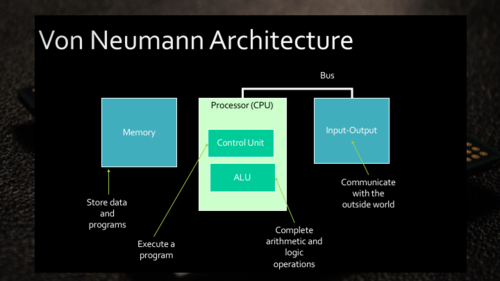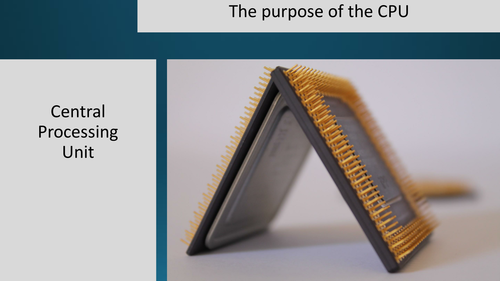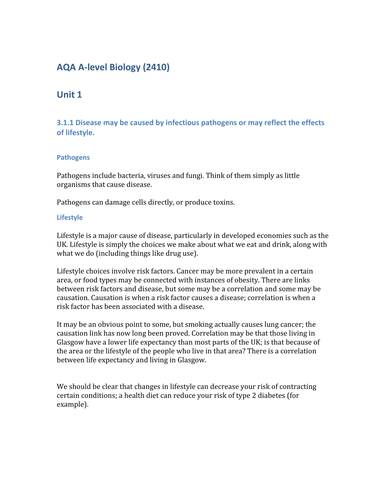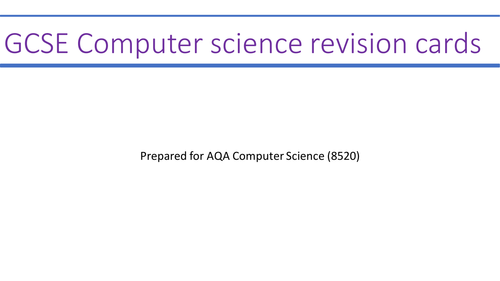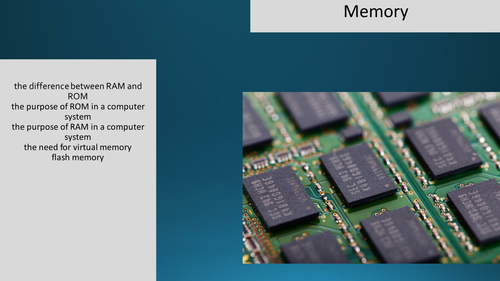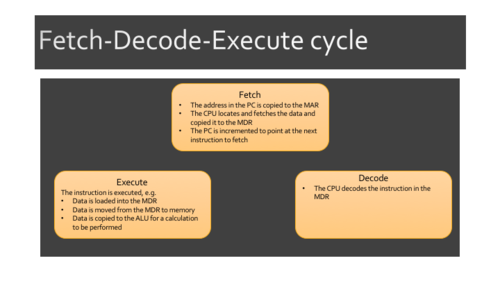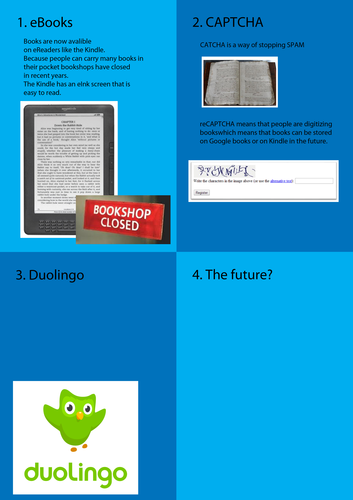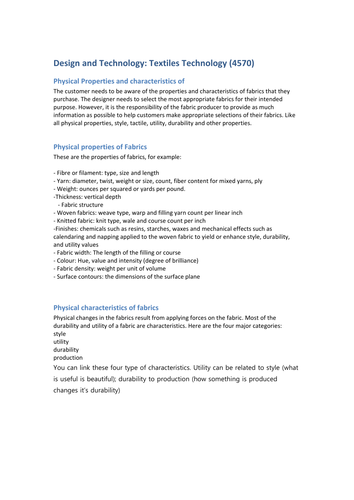
546Uploads
228k+Views
80k+Downloads
All resources

OCR - (9-1) Computer Science GCSE - Legislation - Law
A 30 slide presentation covering everything needed to know about the -
Data protection act
Computer Misuse act
Freedom of Information act
Copyright, Designs and Patents Act
Creative Commons

Google webquest
A web quest that can be used as a self-directed activity for students to help their proficiency in using Google.

Von Neumann
Lesson presentation for the Vonn Neumann architecture. Designed for OCR Computer Science (9-1) J276 but is more than useful for Computer Science students studying AQA and other exam boards.
Contains the PowerPoint presentation (complete with diagrams)
Contains everything the students need to know:
Basics of the Von Neumann architecture.
MAR (Memory Address Register)
MDR (Memory Data Register)
Program Counter
Accumulator

The purpose of the CPU Lesson GCSE Computer Science for OCR
Complete lesson for the purpose of the CPU. Designed for OCR Computer Science (9-1) J276 but is more than useful for Computer Science students studying AQA and other exam boards.
Contains a PowerPoint presentation, and three basic worksheets.
Contains everything the students need to know:

GCE AS Level Biology Unit 1 notes for AQA
GCE AS Level Biology notes written for the AQA specification Biology (2410).
The topics covered in the revision guide are detailed here:
Unit 1
3.1.1 Disease may be caused by infectious pathogens or may reflect the effects of lifestyle Pathogens
Lifestyle
3.1.2 The digestive system provides an interface with the environment. Digestion involves enzymic hydrolysis producing smaller molecules that can be absorbed and assimilated.
The Digestive system
Proteins
Enzyme action
Enzyme properties
Carbohydrate digestion
3.1.3 Substances are exchanged between organisms and their environment by passive or active transport across exchange surfaces. The structure of plasma membranes enables control of the passage of substances across exchange surfaces. Cells
Plasma membranes
Diffusion
Osmosis
Active transport
Absorption
Cholera
3.1.4 The lungs of a mammal act as an interface with the environment. Lung function may be affected by pathogens and by factors relating to lifestyle. Lung function
The biological basis of lung disease
3.1.5 The functioning of the heart plays a central role in the circulation of blood and relates to the level of activity of an individual. Heart disease may be linked to factors affecting lifestyle. Heart structure and function
The biological basis of heart disease
3.1.6 Mammalian blood possesses a number of defensive functions. Principles of immunology

Santa's Angels Business Studies GCSE Christmas Game
Christmas themed Business Studies GCSE game. Links in with many GCSE topics including profit, negotiating, risk, teamwork and strategy.

Von Neumann Revision Pack for OCR Computer Science
Complete revision pack for the Vonn Neumann architecture. Designed for OCR Computer Science (9-1) J276 but is more than useful for Computer Science students studying AQA and other exam boards.
Contains a revision booklet for the students, and four worksheets.
Contains everything the students need to know:
Basics of the Von Neumann architecture.
MAR (Memory Address Register)
MDR (Memory Data Register)
Program Counter
Accumulator

GCSE Computer Science Revision and Challenge cards for AQA 9-1 GCSE 8520
94 Computer science challenge cards that can be used to extend students. Designed for GCSE Computer Science AQA 9-1 GCSE 8520.
These cards are based on the topics that are examined in GCSE Computer science as end of class plenaries, extension tasks or flipped homework tasks.

Ethical and Legal debates for Pearson Edexcel GCSE in Computer Science
A PowerPoint presentation with over 100 ethical and legal debates for the Pearson Edexcel GCSE in Computer Science.
Helps learners study the following specification reference:
1.8 Ethical, legal, cultural and environmental concerns.
How to investigate and discuss Computer Science technologies while considering:
- ethical issues
- legal issues
- cultural issues environmental issues. privacy issues.
Written by subject specialists, with in depth debates that are relevant to students. Content covers AI, automation, gaming, privacy, hacking, security, cloud services, piracy, copyright, algorithms, emerging technology, wearable technology and more!
The pack includes a voting card that you may choose to use for students to vote, or students can move from one side of the room to another.
A great resource that can be used for starters or plenaries, and can also become the basis of an entire lesson.

Internet Safety Lesson - Managing screen time
A full set of resources for a lesson around screentime.
Covers identifying habits and behaviours (e.g., excessive screen time or video game usage) that can be detrimental to health, and explain how people can be encouraged to adopt healthier alternatives.
Resources include:
Discussions
Brainstorming
Collages
Track your screen time

Understanding customer needs: GCSE Business for Edexcel (9-1) (1BS0)
Understanding customer needs
Specification: GCSE Business for Edexcel (9-1) (1BS0)
1.2.1 Understanding customer needs
Contains presentation to run through with students, and an innovative activity for your students.

Market Segmentation: GCSE Business for Edexcel (9-1) (1BS0)
Market segmentation
Specification: GCSE Business for Edexcel (9-1) (1BS0)
Part of 1.2.3 Market segmentation

Memory Lesson for OCR Computer Science
Complete lesson for Memory. Designed for OCR Computer Science (9-1) J276 but is more than useful for Computer Science students studying AQA and other exam boards.
Contains a PowerPoint presentation, and two worksheets.
Contains everything the students need to know:
the difference between RAM and ROM
the purpose of ROM in a computer system
the purpose of RAM in a computer system
the need for virtual memory
flash memory

Fetch Execute Computer Architecture Lesson for OCR Computer Science
Complete lesson for the Fetch Execute cycle. Designed for OCR Computer Science (9-1) J276 but is more than useful for Computer Science students studying AQA and other exam boards.
Contains a PowerPoint presentation, and two worksheets.

Computing Algorithms Artificial Intelligence, AI and Crowd Sourcing Lesson for KS3
A single lesson to help students understand crowd sourcing.
We are increasingly using artificial intelligence for simple tasks in the business world. Google use algorithms to digitize books. However there is something quite sinister in the way that Google are using the Crowd to work for them, often with the workers unaware that they are working for a large multinational firm.
This lesson is fully resourced and has a complete teacher’s guide. (L2Answers.docx)
There is a full lesson (L2AI2016edc.docx), and a shortened poster lesson (L2AI2016dc.docx)

GCE AS Level Biology Unit 2 notes for AQA
GCE AS Level Biology notes written for the AQA specification Biology (2410).
The topics covered in the revision guide are detailed here:
Unit 2
3.2.1 Living organisms vary and this variation is influenced by genetic and environmental factors. Investigating variation
Causes of variation
3.2.2 DNA is an information-carrying molecule. Its sequence of bases determines the structure of proteins, including enzymes. Structure of DNA
Genes and polypeptides
DNA and chromosomes
Meiosis
3.2.3 Similarities and differences in DNA result in genetic diversity. Genetic diversity
3.2.4 The variety of life is extensive and this is reflected in similarities and differences in its biochemical basis and cellular organisation. Haemoglobin
Carbohydrates
Cells
3.2.5 During the cell cycle, genetic information is copied and passed to genetically identical daughter cells. Replication of DNA
Mitosis
Cell cycle
3.2.6 In complex multicellular organisms, cells are organised into tissues, tissues into organs and organs into systems. Cell differentiation
3.2.7 Factors such as size and metabolic rate affect the requirements of organisms and this gives rise to adaptations such as specialised exchange surfaces and mass transport systems. Size and surface area
Gas exchange
Mass transport
The blood system
The passage of water through a plant
3.2.8 Classification is a means of organising the variety of life based on relationships between organisms and is built round the concept of species. Principles of taxonomy
3.2.9 Originally, classification systems were based on observable features but more recent approaches draw on a wider range of evidence to clarify relationships between organisms. Genetic comparisons
DNA
Proteins
Behaviour
3.2.10 Adaptation and selection are major components of evolution and make a significant contribution to the diversity of living organisms. Antibiotics
Genetic variation in bacteria
3.2.11 Biodiversity may be measured within a habitat. Species diversity
Index of diversity

Induction lesson for Computing Year 7
Ever had the problem that students come into year 7 used to their home computers and how the systems worked at their last school? Perhaps you have set up the machines with a default password and need to get them to change that, but also remember that into the coming weeks and months? This lesson has been created to help you.
WALT
• Understand the computer room rules
• Use an algorithm
WILF
• Access the school network
• Access your user area
• Present the classroom rules

Crest Group project for Business Studies GCSE
Group projects for a new Crest product.
Students work in groups (3 or 4 per group) and develop a presentation for a new product.
Included here is a case study for Crest, teacher presentation and evaluation sheet. You may choose the groups to evaluate each other.

Compression (Text Messages) for Computing (KS3 / GCSE)
An innovative computing worksheet.
Teaches about compression and text messages.
Developed for computing KS3 and GCSE. Moves onto Steganography.

Study notes for AQA Design and Technology: Textiles Technology (4570)
Design and Technology: Textiles Technology (4570)
Suitable for revision or a starting point at the beginning of the year.



